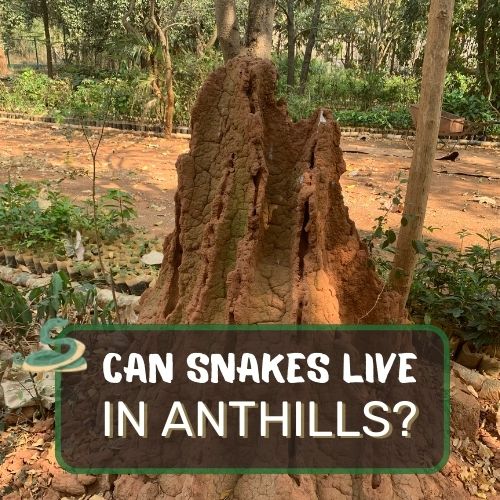
Intrigued by the question “Do snakes live in anthills?”
This engaging article explores the captivating world of snakes and their unexpected relationship with anthills.
Delve into the reasons behind this curious behavior, the factors that attract snakes to these tiny mounds, and the dynamic interactions they share with their ant neighbors.
Discover the adaptations that enable snakes to thrive in these underground sanctuaries and the role of anthills in their reproductive behavior.
From snake predation on ants to the potential dangers they face, this article uncovers the secrets hidden within these seemingly unassuming habitats.
Unravel the mysteries of nature’s interconnectedness and gain a deeper appreciation for the wonders of the natural world.
Table of Contents
- 1 Do Snakes Live in Anthills? Short Answer
- 2 Anthills as a habitat for snakes
- 3 Snake behavior in anthills
- 4 Interactions between ants and snakes in anthills
- 5 Anthills as temporary shelters for snakes
- 6 Snake predation on ants in anthills
- 7 Case studies and observations of snakes in anthills
- 8 Anthills as potential dangers for snakes
- 9 FAQ
- 10 Conclusion
Do Snakes Live in Anthills? Short Answer
Yes, snakes do not typically live in anthills but while they may use anthills as temporary shelters or hunting grounds, they do not make them their permanent residence. Anthills offer some advantages for snakes, such as a source of food and protection, but they primarily prefer other habitats, like burrows, logs, or rocky crevices, for their long-term dwelling.
Understanding the interactions between snakes and anthills provides valuable insights into the complexities of nature’s interconnected ecosystems.
Anthills as a habitat for snakes

Anthills, those tiny mounds of earth bustling with insect activity, might not seem like the most obvious places to find snakes. However, surprisingly, they can serve as potential hiding places for these slithering reptiles.
Anthills as potential hiding places for snakes
Imagine you’re a snake seeking a cozy spot to call home. Anthills offer the perfect cover – a natural fortress camouflaged among the foliage.
These mounds provide a secure environment with narrow openings and chambers, protecting snakes from predators and extreme weather conditions. The warmth retained by the anthills is also appealing to cold-blooded snakes seeking to regulate their body temperature.
But why would snakes choose anthills over other habitats?
Factors that attract snakes to anthills, such as prey availability
For snakes, anthills are like an all-you-can-eat buffet. The abundance of insects and small rodents attracted to the anthills for food provides a reliable source of sustenance for snakes.
It’s like living next door to a gourmet restaurant where the menu is always changing. Snakes are savvy hunters, and anthills offer them a strategic advantage to ambush their prey.
Common snake species found in anthills
While various snake species might take a fancy to the anthill lifestyle, some are more commonly spotted in these earthen abodes.
For example, the Western Hognose Snake is known to burrow near anthills to feast on frogs and toads.
Similarly, the Eastern Indigo Snake, with its impressive size and insatiable appetite, may be found lurking around anthills in search of small mammals and birds.
Snake behavior in anthills

Curious about what goes on inside those anthills where snakes call home? Let’s delve into the intriguing behavior of these serpents in their subterranean sanctuaries.
Reasons why snakes may choose to live in anthills
Snakes are masters of adaptation, and living in anthills offers them several advantages. Apart from the abundant food supply, the narrow tunnels of anthills provide a sense of security for the snakes.
They can retreat to the depths of the anthill to evade predators or harsh weather. Moreover, the constant activity of insects keeps the anthills well-ventilated, ensuring a steady supply of fresh air for the resident snake.
Adaptations of snakes that enable them to thrive in anthills
To thrive in the confined spaces of anthills, snakes have evolved remarkable adaptations.
Their slender bodies and flexible jaws enable them to navigate through tight tunnels, while specialized scales on their belly help with movement in confined spaces.
Some snakes have even developed resistance to ant venom, allowing them to coexist peacefully with their tiny neighbors.
Snake hunting strategies in anthills
Living in close proximity to their prey can be advantageous for snakes. They employ various hunting strategies at night, such as patiently lying in wait near ant trails, ready to strike at passing insects.
Some snakes use their tails to mimic insects, luring unsuspecting prey within striking range. It’s a real-life game of cat and mouse, or rather, snake and ant!
So, next time you come across an anthill, take a moment to appreciate the bustling ecosystem within, where snakes and ants coexist in their own fascinating dance of survival.
It’s a reminder that the natural world is full of surprises and that even the tiniest creatures can find a home in the most unexpected places.
Interactions between ants and snakes in anthills
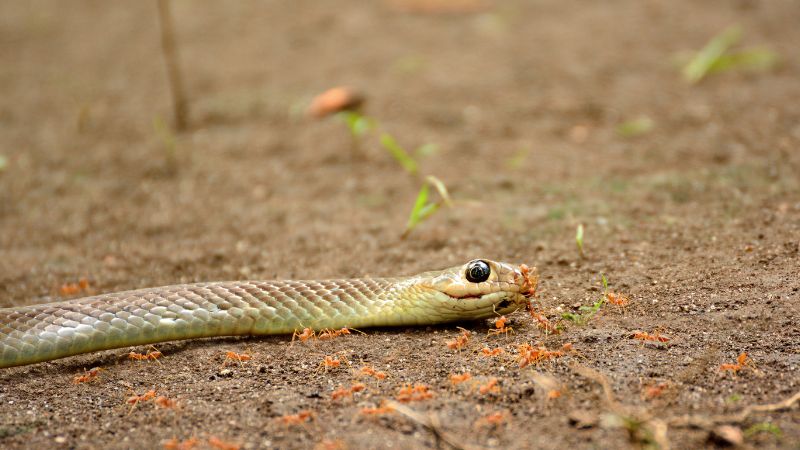
When you think of anthills, it’s natural to picture ants bustling around, but did you know that snakes also share this habitat with their tiny neighbors?
Let’s explore the intriguing relationship between ants and snakes in these underground abodes.
Relationship between ants and snakes
At first glance, you might assume that snakes and ants are natural enemies. However, the reality is far more complex.
While some snake species are opportunistic predators and might occasionally snack on ants, many snakes are quite passive when it comes to their ant neighbors.
Instead of being adversaries, they often coexist peacefully within the anthill.
Mutual benefits and interactions between ants and snakes in anthills
The relationship between ants and snakes can be seen as a mutually beneficial arrangement. Snakes provide pest control services for the ants by preying on insects and small rodents that might otherwise harm the ant colony or compete for resources.
On the other hand, ants offer protection to the snakes by swarming and attacking potential threats, deterring predators from venturing too close to the anthill.
Moreover, some snake species have been observed rubbing their bodies against ant pheromone trails. This behavior might serve to mask their own scent, allowing the snakes to move stealthily and avoid detection by predators or prey.
Ant defense mechanisms against snakes
Ants are not defenseless against snakes. They are known for their incredible collective strength and aggression when threatened.
When a snake encroaches on their territory, ants quickly swarm around the intruder, biting and stinging to protect their home.
For smaller snake species, this ant attack can be quite overwhelming, and the snake might decide to retreat to avoid further confrontation.
Anthills as temporary shelters for snakes
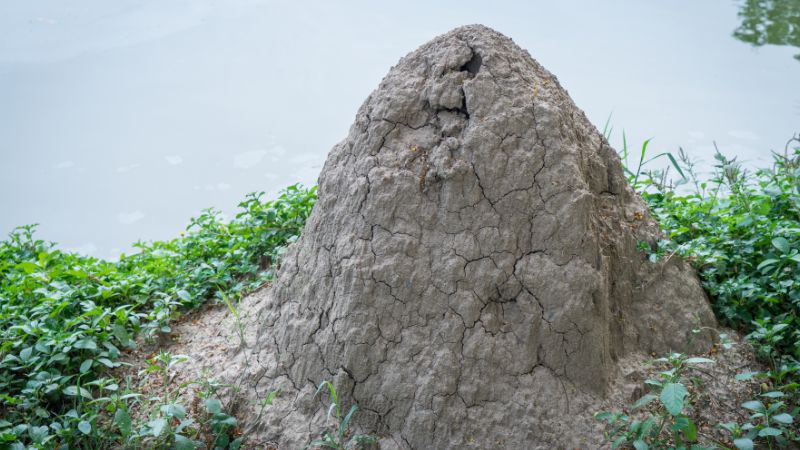
Anthills serve not only as permanent residences but also as temporary shelters for snakes. Let’s explore the reasons why snakes might temporarily seek refuge in these mounds and the role anthills play in their reproductive behavior.
Seasonal migration of snakes to anthills
During certain seasons, snakes might undertake seasonal migrations, seeking out specific environments to fulfill their varying needs.
Anthills provide a safe haven for these snakes during their migratory journeys. The cozy chambers offer protection from predators and provide a reliable source of food while they rest and recharge for the continuation of their journey.
Factors that influence snake occupancy in anthills
The occupancy of snakes in anthills can be influenced by various factors. Availability of prey, temperature, humidity, and the presence of other snakes in the vicinity are some of the key determinants.
For example, during the breeding season, male and female snakes might seek out anthills as potential meeting spots to find mates.
Role of anthills in snake reproductive behavior
Anthills can play a vital role in the reproductive behavior of snakes. Female snakes might utilize the secure and warm environment of anthills to lay their eggs, ensuring a safe and suitable location for their offspring to develop.
This strategy increases the chances of the snake’s progeny surviving and thriving in the natural world.
The fascinating world of snakes and anthills showcases the marvels of nature’s intricacies. As we peel back the layers of this ecosystem, we discover how these seemingly separate entities intertwine and create a delicate balance for survival.
Nature continues to amaze us with its ability to forge unexpected connections, reminding us that every habitat, no matter how small, plays an essential role in the grand tapestry of life.
Snake predation on ants in anthills
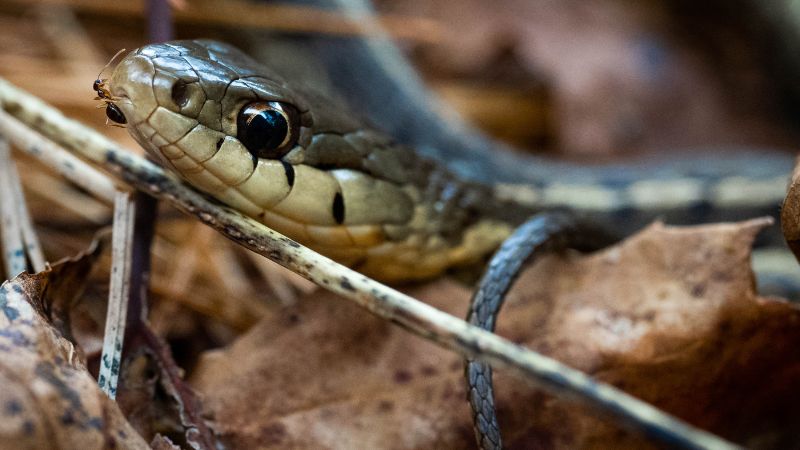
While snakes and ants coexist in anthills, some snake species do target ants as a part of their diet. Let’s take a closer look at the dynamic relationship between snakes and ants within these earthen mounds.
Types of ants targeted by snakes in anthills
Snakes in anthills often prey on various ant species. The targeted ants typically include smaller species that are abundant within the anthill’s immediate vicinity. These may include tiny worker ants that tirelessly scavenge for food and soldier ants that guard the colony.
Snake feeding behavior in anthills
When a snake spots a potential ant meal in an anthill, it uses its impressive hunting skills to strike with precision. Snakes have specialized venomous fangs or constriction abilities to subdue their prey.
Once captured, the snake may quickly consume the ant or, in some cases, carry it back to a more secluded area within the anthill for safer dining.
Impact of snake predation on ant populations
Snake predation on ants can have various effects on the anthill ecosystem. While it might help control certain ant populations, it can also create a disturbance in the delicate balance of the ant colony.
The loss of worker ants, for instance, might impact the colony’s foraging and food-gathering capabilities. However, snakes are not the sole factor affecting ant populations, as other predators and environmental factors also play a role.
Case studies and observations of snakes in anthills
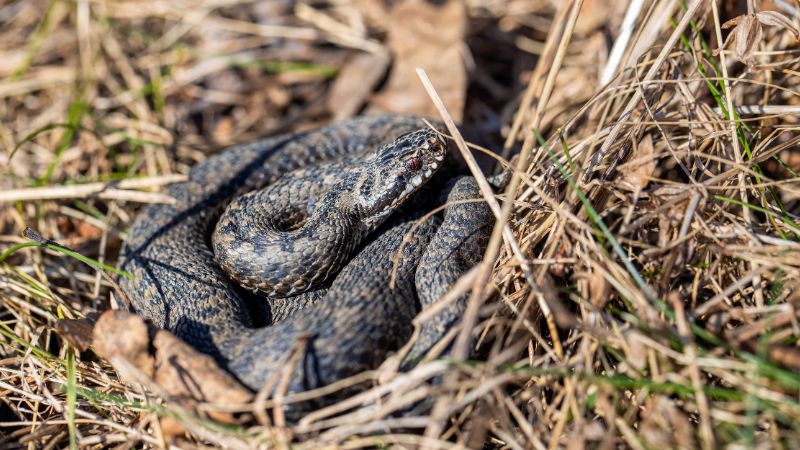
To gain a deeper understanding of snakes in anthills, researchers and enthusiasts have conducted numerous case studies and observations. These endeavors shed light on the fascinating lives of these serpents in their earthy abodes.
Documented instances of snakes living in anthills
Researchers have recorded various instances of snakes taking up residence in anthills. From small venomous species to non-venomous constrictors, snakes of diverse sizes and types have been found cohabitating with ants.
These documented instances offer valuable insights into the ecological dynamics at play within anthills.
Insights from field studies and research on snakes in anthills
Field studies have provided valuable data on snake behavior, interactions with ants, and the factors influencing their presence in anthills.
Researchers have observed how snakes adapt their hunting strategies to exploit the abundant insect life and how ants respond to snake presence.
Photographs and videos of snakes in anthills
Photographs and videos captured during field research and by wildlife enthusiasts offer captivating glimpses of snakes in their underground habitats.
These visual records provide a unique perspective into the lives of these elusive creatures and the intricate world they share with ants in anthills.
By delving into case studies and observing snakes in their natural habitat, scientists continue to deepen their understanding of these enigmatic creatures.
Through their discoveries, we come to appreciate the beauty and complexity of the relationship between snakes and ants within the fascinating microcosms of anthills.
Anthills as potential dangers for snakes

While anthills offer shelter and food for snakes, they also present certain risks and threats that these reptiles must contend with.
Risks and threats snakes may face in anthills
One of the primary dangers for snakes in anthills is the risk of becoming trapped. The narrow tunnels and chambers, while providing protection, can also be challenging to navigate, especially for larger snake species.
Getting stuck in tight spaces can lead to fatal consequences for the snake. Additionally, disturbances caused by humans or other animals might result in collapsed tunnels, further endangering snakes residing in the anthills.
Predators and competitors of snakes in anthills
Anthills are bustling ecosystems, and snakes are not the only inhabitants. Various predators and competitors coexist within these mounds, posing potential threats to the snakes.
Larger predators like birds of prey and mammals may prey on snakes within the anthill or nearby areas.
Additionally, competition for food and resources with other inhabitants, such as spiders or centipedes, can be challenging for snakes.
Human activities that impact snake populations in anthills
Human activities, such as construction, deforestation, and agriculture, can significantly impact snake populations in anthills.
Destruction of natural habitats for anthills can lead to the displacement or extermination of snakes. Chemical pesticides used in agricultural practices can also harm snakes and their ant prey, disrupting the delicate balance of the ecosystem.
FAQ
What is the relationship between ant and snake?
The relationship between ants and snakes in anthills is complex and multifaceted. While some snake species might prey on ants as part of their diet, others coexist peacefully with the ant colony, forming a mutually beneficial association. Snakes benefit from the secure shelter and abundant food supply provided by the anthills, while ants gain protection from potential threats through the presence of snakes, which may deter predators.
Will ants hurt my snake?
While ants may exhibit aggressive behavior when threatened, they generally pose little danger to healthy adult snakes. Larger snake species are unlikely to be significantly affected by ant attacks. However, for smaller or juvenile snakes, swarming ants can be a nuisance and might lead to temporary discomfort. It is essential to monitor your pet snake’s environment and ensure it remains in good health, as even minor injuries can be problematic.
In summary, anthills are not just ordinary mounds of dirt; they serve as microcosms of life, offering unique habitats for a diverse range of species, including snakes. As we learn more about the interactions and adaptations of snakes in these underground sanctuaries, we gain a deeper appreciation for the intricate web of life that exists within even the tiniest corners of the natural world.
Conclusion
Throughout this journey into the fascinating world of snakes in anthills, we’ve uncovered the intricate dynamics of this unique ecological relationship. Let’s recap the key points discussed and reflect on the significance of understanding this intriguing aspect of nature.
In this article, we explored how anthills serve as potential hiding places and temporary shelters for snakes. We learned about the factors that attract snakes to anthills, their behavioral adaptations, and hunting strategies.
Additionally, we delved into the interactions between ants and snakes, highlighting their mutual benefits and the defense mechanisms employed by ants.
Moreover, we touched upon the potential dangers faced by snakes in anthills, including the presence of predators and human-induced threats.

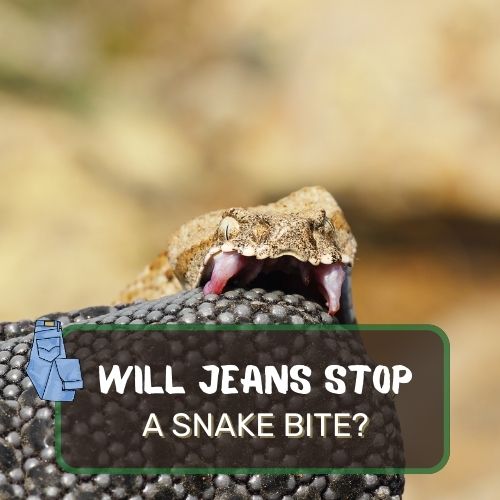


0 Comments